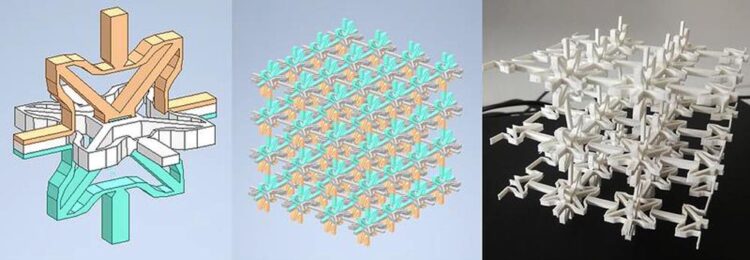Changing shapes at the push of a button

Left: Unit cell made up of structural elements; Center: Material structure comprised of multiple cells; Right: 3D-printed demonstrator
© Fraunhofer IWM
Programmable materials are true shapeshifters. They can change their characteristics in a controlled and reversible way with the push of a button, independently adapting to fit new conditions. They can be used, for example, to make comfy chairs or mattresses that prevent bedsores. To produce these, the support is formed in such a way that the contact surface is large which, as a result, lowers the pressure on parts of the body. This type of programmable material is being developed by researchers at the Fraunhofer Cluster of Excellence Programmable Materials CPM, who plan to bring it to the market with the help of industry partners. One of their goals is to reduce the use of resources.
Many people across the world are bedridden – be it due to illness, an accident or old age. Because those affected often cannot move or turn over by themselves, they often end up with very painful bedsores. In the future, it should be possible to avoid bedsores with the help of materials that can be programmed to entirely adapt their form and mechanical properties. For example, the body support of mattresses made from programmable materials can be adjusted in any given area at the push of a button. Furthermore, the support layer is formed in such a way that strong pressure on one point can be distributed across a wider area. Areas of the bed where pressure is placed are automatically made softer and more elastic. Caregivers can also adjust the ergonomic lying position to best fit their patient.
Materials and microstructuring
Materials for applications requiring specific changes to stiffness or shape are being developed by researchers from Fraunhofer CPM, which is formed of six core institutes with the aim of designing and producing programmable materials. So, how can we program materials? “Essentially, there are two key areas where adjustments can be made: the base material – thermoplastic polymers in the case of mattresses and metallic alloys for other applications, including shape memory alloys – and, more specifically, the microstructure,” explains Dr. Heiko Andrä, spokesperson on the topic at the Fraunhofer Institute for Industrial Mathematics ITWM, one of the Fraunhofer CPM core institutes. “The microstructure of these metamaterials is made up of unit cells that consist of structural elements such as small beams and thin shells.” While the size of each unit cell and its structural elements in conventional cellular materials, like foams, vary randomly, the cells in the programmable materials are also variable – but can be precisely defined, i.e., programmed. This programming can be made, for example, in such a way that pressure on a particular position will result in specific changes at other regions of the mattress, i.e., increase the size of the contact surface and provide optimal support to certain areas of the body.
Materials can also react to temperature or humidity
The change in shape that the material should exhibit and the stimuli to which it reacts – mechanical stress, heat, moisture or even an electric or magnetic field – can be determined by the choice of material and its microstructure. “The programmable materials allow to adapt products to the specific application or person so that they are more multifunctional than before. As such, they do not need to be swapped out as often. It is particularly interesting in the context of material saving and sustainability,” says Franziska Wenz, deputy spokesperson on the topic at the Fraunhofer Institute for Mechanics of Materials IWM, another core institute of Fraunhofer CPM. This can also create added value, whereby products are adapted to the individual needs of the users.
The journey to application
A single piece of material can take the place of entire systems of sensors, regulators and actuators. The goal of Fraunhofer CPM is to reduce the complexity of systems by integrating their functionalities into the material and reducing material diversity. We always have industrial products in mind when developing the programmable materials. As such, we take mass production processes and material fatigue into account, among other things,” says Wenz. The initial pilot projects with industry partners are also already underway. The research team expects that initially, programmable materials will act as replacements for components in existing systems or be used in special applications such as medical mattresses, comfortable chairs, variable damping shoe soles and protective clothing. “Gradually, the proportion of programmable materials used will increase,” says Andrä. Ultimately, they can be used everywhere – from medicine and sporting goods to soft robotics and even space research.
Weitere Informationen:
https://www.fraunhofer.de/en/press/research-news/2023/january-2023/changing-shap…
Media Contact
All latest news from the category: Materials Sciences
Materials management deals with the research, development, manufacturing and processing of raw and industrial materials. Key aspects here are biological and medical issues, which play an increasingly important role in this field.
innovations-report offers in-depth articles related to the development and application of materials and the structure and properties of new materials.
Newest articles

First-of-its-kind study uses remote sensing to monitor plastic debris in rivers and lakes
Remote sensing creates a cost-effective solution to monitoring plastic pollution. A first-of-its-kind study from researchers at the University of Minnesota Twin Cities shows how remote sensing can help monitor and…

Laser-based artificial neuron mimics nerve cell functions at lightning speed
With a processing speed a billion times faster than nature, chip-based laser neuron could help advance AI tasks such as pattern recognition and sequence prediction. Researchers have developed a laser-based…

Optimising the processing of plastic waste
Just one look in the yellow bin reveals a colourful jumble of different types of plastic. However, the purer and more uniform plastic waste is, the easier it is to…



